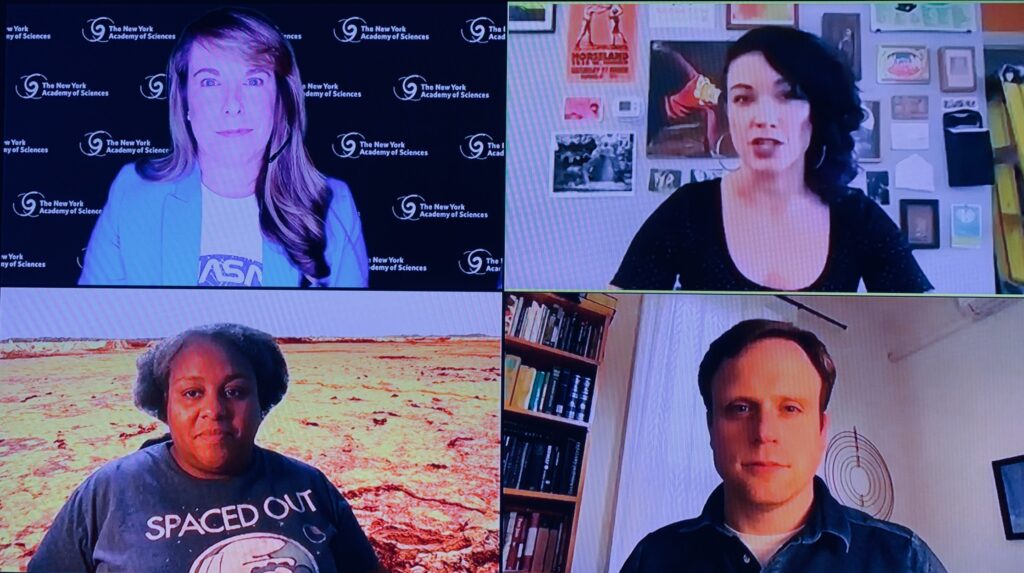Could we Genetically Protect Astronaut Health on the Mission to Mars?
Beyond Spacesuits and Pain Relievers: Could we Genetically Protect Astronaut Health on the Mission to Mars? On May 12, 2020, I hosted a virtual conversation for the New York Academy of Sciences with astrobiologist Kennda Lynch, PhD (Lunar and Planetary Institute), geneticist Christopher Mason, PhD (Weill Cornell Medicine), and planetary scientist Lucianne Walkowicz, PhD (The JustSpace Alliance; Adler Plantarium) exploring some of the physical—and ethical—obstacles to be surmounted for a successful human mission to Mars.
Published May 12, 2020
By Brooke Grindlinger, PhD
Chief Scientific Officer
Much has been written about finding the next Earth—a planetary body to serve as future outpost for the human race as Earth’s life-sustaining natural resources dwindle. But Mars won’t exactly offer a warm welcome to unshielded humans: an average temperature of -80°F/-62°C, an atmosphere of 96% toxic carbon dioxide, a surface covered in fine red dust, and a hefty dose of radiation constantly tearing through your DNA. Hostile welcome aside, we first have to get there safely.
Are We There Yet?

With current jet propulsion technologies, and depending on the position of the red planet in its orbit, the shortest journey from Earth to Mars is estimated to take 6 months. As revealed by NASA’s study of identical twins Scott and Mark Kelly—undertaken before, during, and after Scott embarked on his one-year mission on the International Space Station—long-term space flight can exact a multitude of transient and permanent effects on the human body: from loss of muscle tone and bone density to changes in vision and the body’s ability to repair itself.
A round trip is expected to eclipse the lifetime maximum recommended dosage of radiation. We humans are hardy, but are we tough enough for the mission to Mars?
Beyond the Whims of Evolution
While we don’t yet know if there is life on Mars, or if it had life in the past, a peek at the vast diversity of life right here on Earth reveals lifeforms that can survive in harsh environments that resemble the Martian surface. Some extremophiles—organisms that thrive in high radiation or very dry, salty, acidic, hot or cold settings—may be better equipped than Homo sapiens for life on Mars. Could they serve as a genetic reservoir in which to fish for talents and traits that if introduced into humans would make us more resilient?
The gene editing technique CRISPR, or the synthetic redesign of organisms to engineer new abilities, could propel astronaut preparation forward through strategic genetic enhancement of the human body or the custom design of microbes that support daily life on Mars. Imagine a designer microbe that secretes materials that catalyze concrete production from Mars soil, or supports water production, waste disposal, or plant growth. Genes taken from the humble tardigrade—a microscopic creature genetically resistant to radiation damage—when inserted into human cells, have been shown to provide protection against radiation. Along with physical and pharmacological protections—from spacesuits to pain relievers—could we safely genetically protect astronaut heath? And if so, should we?
The Big Experiment
When human medical studies are conducted, patients must be fully apprised of the risks and willingly give their consent to participate. If at any time the patient wishes to leave the study, they can withdraw their consent and go home. No such U-turns will be available to astronauts when months into their journey to Mars. The risks associated with space travel are carefully calculated, and many regulations in place to protect astronaut health.
However, as we push the human body to, and perhaps beyond, reasonable limits, this begs the question: are the health risks so high that extreme methods of protection like gene editing or synthetic biology would be justified? Are we in fact ethically bound to pursue these methods of protection because the risk of not pursuing them is too great? While these technologies are still in exploratory stages today, it’s intriguing to think of the future possibilities, and ethical quandaries, that may be realized on the fourth or fifth generation missions to Mars.
Mars may only be half the size of Earth, but it will pack one heck of a sensory punch for the astronauts anticipated to touch down on the red planet by 2035. As the fantastic future of human space travel continues to unfold before us, the challenges of sustaining human life in space should, in parallel, drive us to live more sustainably here on Earth in the here and now.
This article was originally published on LinkedIn.
Also read: Big Questions for Our Journey to Mars
